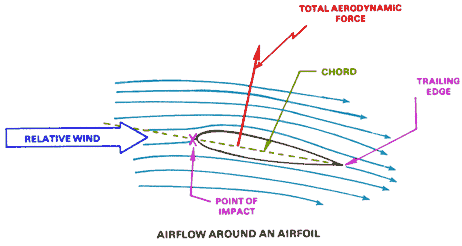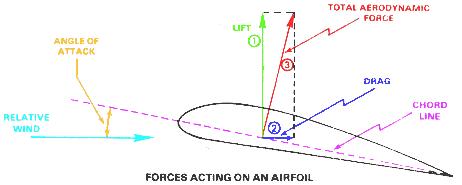


A high pressure area or stagnation point is formed at the point of impact. Normally the high pressure area is located at the lower portion of the leading edge, depending on angle of attack. This high pressure area contributes to the overall force produced by the blade.
This picture also shows airflow lines that illustrate how the air moves about the airfoil section. Notice that the air is deflected downward as it passes under the airfoil and leaves the trailing edge. Remember Newton's third law which states "every action has an equal and opposite reaction." Since the air is being deflected downward, an equal and opposite force must be acting upward on the airfoil. This force adds to the total aerodynamic force developed by the airfoil. At very low or zero angles of attack, the deflection force or impact pressure may exert a zero positive force, or even a downward or negative force.
Air passing over the top of the airfoil produces aerodynamic force in another way. The shape of the airfoil causes a low pressure area above the airfoil according to Bernoulli's Principle, and the decrease in pressure on top of the airfoil exerts an upward aerodynamic force. Pressure differential between the upper and lower surface of the airfoil is quite small - in the vicinity of 1 percent. Even a small pressure differential produces substantial force when applied to the large area of a rotor blade.
The total aerodynamic force, sometimes called the resultant force, may be divided into two components called lift and drag. Lift acts on the airfoil in a direction perpendicular to the relative wind. Drag is the resistance or force that opposes the motion of the airfoil through the air. It acts on the airfoil in a direction parallel to the relative wind:

Many factors contribute to the total lift produced by an airfoil. Increased speed causes increased lift because a larger pressure differential is produced between the upper and lower surfaces. Lift does not increase in direct proportion to speed, but varies as the square of the speed. Thus, a blade traveling at 500 knots has four times the lift of the same blade traveling at only 250 knots. Lift also varies with the area of the blade. A blade area of 100 square feet will produce twice as much lift as a blade area of only 50 square feet. Angle of attack also has an effect on the lift produced. Lift increases as the angle of attack increases up to the stalling angle of attack. Stall angle varies with different blades and is the point at which airflow no longer follows the camber of the blade smoothly. Air density is another factor that directly influences lift.
Two design factors, Airfoil Shape and Airfoil Area are primary elements that determine how much lift and drag a blade will produce. Any change in these design factors will affect the forces produced.
Normally an increase in lift will also produce an increase in drag. Therefore, the airfoil is designed to produce the most lift and the least drag within normal speed ranges.
 Return to Dynamic Aerodynamics!
Return to Dynamic Aerodynamics!
 Return to Dynamic Flight
Return to Dynamic Flight
Copyright ©1999-2017 Dynamic Flight, Inc. All rights reserved.
Page Last Updated on: Nov-06-2017